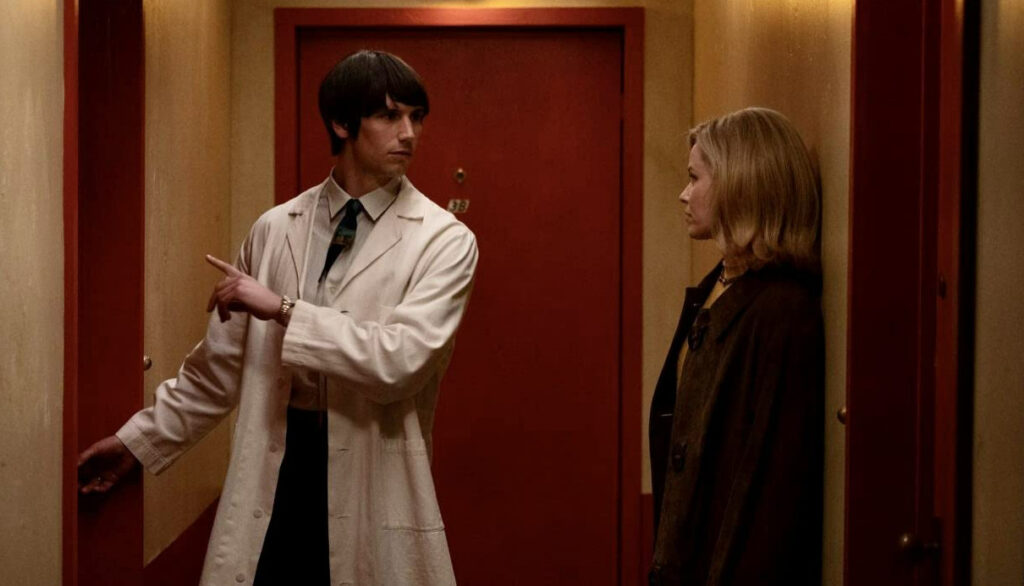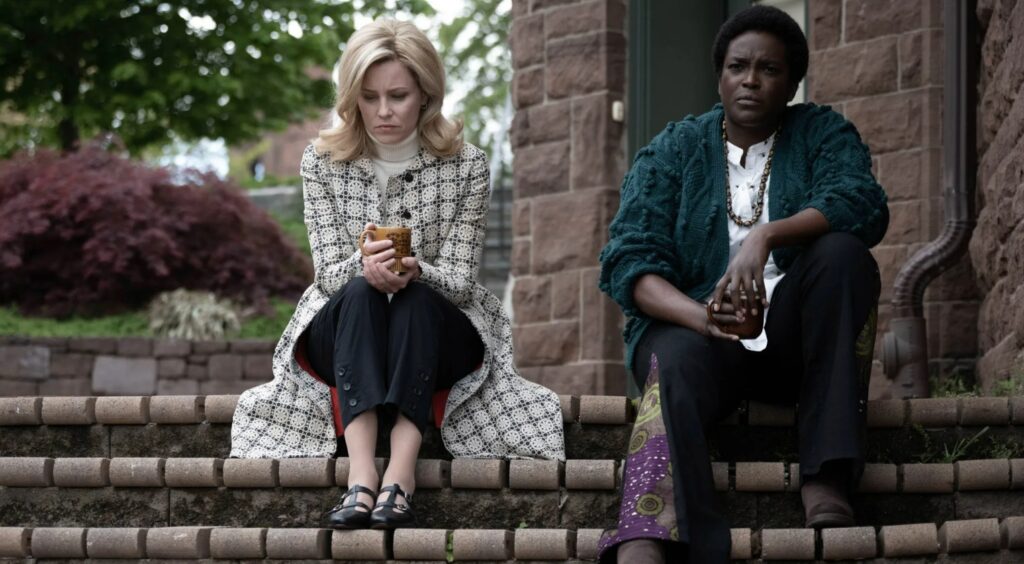As we all know, the best-laid plans of mice, men, and women, often go awry. But sometimes, that leads to something bigger and better. Such is the case with director Phyllis Nagy. Thanks to the bottom falling out on another project Nagy was planning to direct, it opened her calendar so that she could come aboard to direct one of the most important films of the year – CALL JANE, starring Elizabeth Banks and Sigourney Weaver.
Directed by Nagy in her feature film directorial debut (she previously directed the 2005 television movie “Mrs. Harris”) and written by Hayley Schore and Roshan Sethi, CALL JANE is the story of suburban Chicago housewife Joy, wife of a successful attorney who has just made partner in his law firm, and mother of a teenaged daughter. The time is August 1968. A volatile time in our country’s history (and if you don’t know why I suggest you Google it or pick up a history book). Mores were changing. There was civil unrest. Women were speaking up and shifting their roles in the home and in the world. And abortion was illegal.

It may surprise many that until the late 19th century, abortion was legal in the United States, typically until about the fourth month of pregnancy. In the 1820s and 1830s, early regulations kicked in that dealt with the sale of drugs that women used to induce abortions. They were dangerous and often proved fatal yet commerce prevailed and they were sold until the 1880s when abortion was finally outlawed across most of the United States. But in the 1960s, more control on women and their bodies came to the fore with court cases involving contraceptives. (It was these lawsuits that laid the groundwork for the landmark Roe vs Wade.) So what were women to do with unwanted or unsafe pregnancies? For those who could afford it, they travelled to other countries where safe and legal abortions were being performed. Another option was paying large sums of money to a doctor in the United States willing to risk his license and perform the procedure. And finally, there was the option of less-than-safe illegal back-alley or self-induced abortions. This is what led to the founding of the abortion counseling service known as The Jane Collective and the “Call Jane” flyers that popped up around Chicago (and elsewhere) in the 1960s and 70s; underground abortion clinics that provided safe abortion procedures for women.
As for Joy, she’s a stay-at-home mom to teenaged Charlotte, keeps a perfect home, edits her husband Will’s legal briefs, gets dinner on the table at 6pm every night and looks as glamorous as can be when arm candy to her husband at fancy functions. And she has time to hang out on her widowed neighbor Lana’s porch shooting the breeze and talking light politics while Lana espouses the virtues of “Diary of a Mad Housewife” which she is reading. But what happens when Joy finds out she’s pregnant, some 14 or 15 years after giving birth to Charlotte?

Initially ecstatic at the thought of another baby, things take a turn for the worse when Charlotte passes out while making dinner and dancing in the kitchen to “The Velvet Underground.” A cardiomyopathic condition has come to light, worsened by her pregnancy. If Joy is to survive, she needs an abortion. Unfortunately, the hospital and its Board – all men – will not approve the procedure absent two psychiatrists stating Joy is suicidal. Easier said than done, especially when Joy is anything but suicidal. And straightlaced husband Will refuses to use the muscle of his law firm to put pressure on the hospital.
Given a “Plan B” by one psychiatrist, Joy secretly heads to a seedy part of town for an abortion. Overcome by fear and the dirt and filth of this back-alley world, she runs away in a panic only to see a flyer posted by a bus sign that says CALL JANE.

Steeling up all of her courage, Joy does CALL JANE. Picked up by the kindly and confident Gwen, Joy is driven blindfolded to a secret location, pays her $600 (obtained by a cloak and dagger forging of her husband’s check at the bank), meets Dr. Dean who will be performing the procedure, and submits to it. The calm and deliberateness with which Nagy and cinematographer Greta Zozula immerse us into the moment and Joy’s emotional state is powerful. But Joy’s experience is the pivotal moment in this film and the care and personalization of its telling are what makes the tone and emotion of the balance of the film soar.
Embraced by “The Janes” and founder Virginia post-procedure, Joy is cared for, fed, and given instructions for recovery at home. She is not left on her own to flounder and wallow in grief, fear, and sadness. There is a welcoming warmth from these women, so welcoming in fact, that it doesn’t take long before Joy lends a hand by taking another young woman through the journey, and then another, and another, and…

Character-driven with a compelling protagonist in Joy, Elizabeth Banks delivers an award-worthy performance built upon nuanced emotional complexity and intelligence. Banks makes Joy completely relatable to the average woman while evoking empathy from even the toughest pro-lifers. She is so gifted at facial expressiveness to reflect shifting emotions within Joy. Matching Banks note for note as Virginia, Sigourney Weaver is tough as nails in her conviction to provide women a safe alternative to back-alley filth and incompetence, protective of their rights to privacy and health care, as well as protecting the secrecy of the group. She never wavers nor falls victim to sentimentality. Long a fighter, Virginia knows what it takes to navigate the system for the greater good.
Thanks to Schore and Sethi, and under Nagy’s assured direction, CALL JANE tackles more than the abortion issue, calling attention to racial and economic disparity, religious and male-dominated corporate influences, as well as the perspective of the younger generation, but doing so without detracting from Joy’s story and POV. And as we see, the issue of abortion is an umbilical cord that connects them all. This is a carefully threaded needle that allows sub-plots of the 1960’s world in which CALL JANE takes place to be addressed through strong performances from Wunmi Mosaku as Gwen, Aida Turturro as Sister Mike, Grace Edwards as Charlotte, and Chris Messina as Joy’s husband Will. All voices are heard in CALL JANE. Notable is Edwards’ performance as the conflicted Charlotte who just wants to “tune out” the world, the war, politics, and everything else, only to find the issues of the world now in her living room.

One of the most fascinating characters in CALL JANE is Dr. Dean who comes to life, albeit with a coat of arrogant sleaze, courtesy of Cory Michael Smith. On meeting Dr. Dean, you feel his lack of sympathy or human connection; his cockiness, his “I’m doing you a favor”, and “money is all he knows” persona make you bristle. Not to be missed is a key scene between Weaver and Smith which may find you applauding and cheering Virginia’s abilities and skill when pitted against the good doctor. Similarly, a standout point-counterpoint between Banks and Smith. And you’ll be gripping the arms of your chair when John Magaro’s Detective Chilmark shows up at Joy’s house. Talk about a well-paced plot twist!
Starting with the exemplary script by Schore and Sethi, Nagy surrounds herself with impressive artisans to bring CALL JANE to life through visual and emotional tonal bandwidth. And Phyllis Nagy is nothing if not detail oriented.
Steeping us in time and place, Greta Zozula’s lighting and lensing is outstanding, with lighting being very key in tonal shifts. Shot on Super 16mm film, we see and feel the grain of time and are transported and immersed. Shots are held and never rushed, giving the characters and the audience time to absorb and reflect what is happening in the world; metaphorically speaking to the thought that is given when deciding whether or not to have an abortion. In the first act we feel the weight and the oppressiveness of Joy’s world and the specter of her pregnancy. Small kitchen, small tightly framed bedroom, fenced porches. Key moments employ slo-motion as a means of exposition that let us see and feel the emotion rather than hear words. And as CALL JANE progresses and Joy expands her own world and viewpoint, framing opens up and widens incrementally, lighting and color palette shift and get brighter. Nagy and Zozula embrace the “breaking out of female stereotypes” with their visual tonal bandwidth while not hitting anyone over the head. Again, it’s Nagy’s light-touch approach that is so wonderful to experience.

Jona Tochet’s production design is glorious as is the costume design of Julie Weiss. Period perfect, most notably in Charlotte’s bedroom which encapsulates 1968 for us with posters on the wall, the colors, the transition not only of a teenager but of the world. A light touch of humor is often present through production design and set dress; a husband complaining about Swanson TV Dinners (meatloaf, no less, and it was one of the best!), and we see the period-perfect boxes go into the freezer, Virginia feeding post-procedure women with the comfort food of spaghetti, etc. Costuming includes granny square crocheted tops, natural fibers and Birkenstock-esque footwear, middle America Audrey Hepburn cotton pedal-pushers, flower power, and the moire silk nightlife glamour, just to name a few of the gems here.
Bringing it all together is Peter McNulty’s masterful editing. McNulty isn’t afraid to let the film or a scene take its time, to breathe. It’s almost chilling as the camera moves through each step of the procedure and the shot is held on each instrument that’s going to be used. He and Nagy let us absorb and think about what the procedure entails. It also builds tension in allowing us to empathize with the woman in the stirrups. And by the same token, he knows when a lighter touch is necessary as with one or two of the montages or when the camera is going 360 degrees in the “headquarters” of The Janes and the women are talking fast and furious, excited by the movement forward of their mission.

The icing on the cake is a meld of Isabella Summers’ score and period-perfect needledrops that features music by women of the 60s. Summers leans into an elegance with the score that lends itself to the social and political upheaval and transition of the time while invoking a strong sense of optimism at film’s end. The needledrops often serve as a contrasting juxtaposition to the score and are very effective during montages that pepper the film.
Standout with CALL JANE is that it’s non-judgmental. All of the considerations and potential ramifications of an abortive medical procedure are presented and played out with no judgment. CALL JANE embraces every walk of life, every kind of woman, every race, every creed, every color and lays bare the totality of the circumstances for all women and society as a whole; where we were then and where we are once again today in a Roe-defeated world. Seemingly prescient although shot before the recent Supreme Court ruling on Roe vs Wade, CALL JANE is a call to action for our times.
Directed by Phyllis Nagy
Written by Hayley Schore & Roshan Sethi
Cast: Elizabeth Banks, Sigourney Weaver, Chris Messina, Aida Turturro, Wunmi Mosaku, Grace Edwards, Cory Michael Smith, John Magaro
by debbie elias, 10/25/2022












